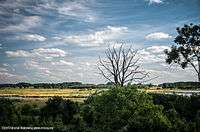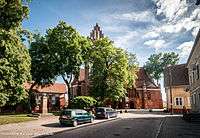Morąg
| Morąg | |||
|---|---|---|---|
|
Town view | |||
| |||
 Morąg | |||
| Coordinates: 53°55′N 19°56′E / 53.917°N 19.933°E | |||
| Country |
| ||
| Voivodeship | Warmian-Masurian | ||
| County | Ostróda | ||
| Gmina | Morąg | ||
| Established | 13th century | ||
| Town rights | 1327 | ||
| Government | |||
| • Mayor | Tadeusz Zbigniew Sobierajski | ||
| Area | |||
| • Total | 12.17 km2 (4.70 sq mi) | ||
| Population (2006) | |||
| • Total | 14,497 | ||
| • Density | 1,200/km2 (3,100/sq mi) | ||
| Time zone | CET (UTC+1) | ||
| • Summer (DST) | CEST (UTC+2) | ||
| Postal code | 14-300, 14-331 | ||
| Area code(s) | +48 89 | ||
| Car plates | NOS | ||
| Website | http://www.morag.pl | ||
Morąg [ˈmɔrɔŋk] (German: Mohrungen (![]() listen)) is a town in northern Poland in Ostróda County in the Warmian-Masurian Voivodeship about 60 km (37.28 mi) south of the Polish - Russian border. The nearest city is Olsztyn, 44 km to the southeast.
listen)) is a town in northern Poland in Ostróda County in the Warmian-Masurian Voivodeship about 60 km (37.28 mi) south of the Polish - Russian border. The nearest city is Olsztyn, 44 km to the southeast.
History
The settlement existed as an Old Prussian town known under the name of Mawrin, Maurin or Morin.[1] A new town was built on its place by the invading Teutonic Knights after they destroyed the original settlement. It was given the name Mohrungen and in 1327 attained Kulm law from Hermann von Oettingen. The original inhabitants of the town were emigrants from the southern Harz in central Germany. The War between the Teutonic Order and Poland saw the town incinerated completely in 1414. Mohrungen was occupied by the Grand Duchy of Lithuania and the Kingdom of Poland from 1410 to 1461.
Mohrungen was on a shipping commerce line connecting Truso with harbors at the Black Sea. Agriculture and commerce was the primary occupations in the town. It was known as a cattle and grain market.[2]
From 1525 to 1701 Mohrungen was part of Ducal Prussia and became part of the Kingdom of Prussia in 1701. It was the seat of the district administration of Landkreis Mohrungen since 1752. An earthquake struck the town in 1818. Until 1945 Mohrungen belonged to Germany. After World War II the local populace was expelled and the town became part of Poland as Morąg.
From May 2010 to 2011 the town was the garrison of a US Army Patriot Missile Defense battery.[3]
Sights
After a fire in 1697 only the castle and the church, which was restored and rebuilt several times, survived. Following World War II in 1945 fires burnt about 45% of the town. Only the outer walls of the town hall remained.
- The old castle of the Teutonic Knights is being excavated as more of it has been recently discovered.
- The "Dohna-Schlößchen" (Dohna Palace), which was mostly destroyed in the Second World War, was restored in 1986. Now it houses the Museum of Johann Gottfried Herder, an impressive regional museum.
- The main body of the Catholic church of Saint Peter and Saint Paul goes back to the first half of the 14th century.
- The town hall, damaged in the Second World War, was rebuilt from 1947-1954 as it looked before.
- Some ruins of the original town walls still remain.
- Kretowiny (Kranthau), a popular lake and camp ground are only 9 km away and are a favorite and frequent retreat for the local population.
Population
- 1740: 1,067
- 1782: 1,753
- 1820: 2,108
- 1880: 3,742
- 1885: 3,879
- 1890: 3,780
- 1900: 4,025
- 1910: 4,147
- 1925: 4,934
- 1933: 5,414
- 2003: 14,570
- 2010: 13,895[4]
Famous residents
- Christoph von Dohna (1583–1637), German politician
- Abraham Calovius (1612–1686), Lutheran theologian
- Johann Gottfried von Herder (1744–1803), German author, Lutheran theologian, and eminent enlightenment philosopher
- Friedrich von Zander (1791–1868) Prussian Chancellor
- Gustav Hermann Schmischke (1883-unknown), Gauleiter
- Elisabeth von Thadden (1890–1944), German educator
- Reinold von Thadden-Trieglaff (1891–1976), German theologian
- Alfred Jaedtke (1913–1992), Wehrmacht officer
- Gerhard Bondzin (born 1930), German painter - Gallery
- Bernd Heine (born 1939), German linguist
- Zbigniew Nienacki (1929–1994), Polish writer
- Cezary Worek (1965- ), researcher at the AGH University of Science and Technology in Kraków
 Morąg Old Town
Morąg Old Town Morąg Marsh
Morąg Marsh St. Peter and St Paul's church, Morąg
St. Peter and St Paul's church, Morąg Ogrodowa Street, Morąg
Ogrodowa Street, Morąg
Religion
Pastoral activity in the town is the Roman Catholic Church and the Pentecostal Church - Protestant community on the nature of the Gospel, as well as the Greek Orthodox Church.[5]
References
- ↑ http://www.morag.pl/historia.html
- ↑ Cohen, Saul B., "The Columbia Gazetteer of the World." Columbia University Press, 1998.
- ↑ Poland welcomes US soldiers, Patriot missiles
- ↑ The Population. The status and structure of the territorial section (as of 31 XII 2010). Warsaw: Central Statistical Office, 2011-06-10. ISSN 1734-6118.
- ↑ A. Kopiczko, Panorama, religion of the Olsztyn after World War II, pp. 63, 64
| Wikimedia Commons has media related to Morąg. |
External links
- Municipal website (Polish)
Coordinates: 53°55′N 19°56′E / 53.917°N 19.933°E

